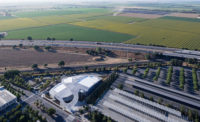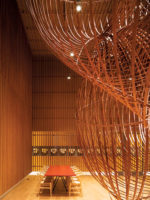Times Square Reconstruction by Snøhetta
New York City

Photo © Michael Grimm

Photo © Michael Grimm

Photo © Michael Grimm

Photo © Michael Grimm




Architects & Firms
Redesigning one of the world’s most visited places is no small feat. In 2010, Snøhetta was selected to transform Times Square in Midtown Manhattan from a congested crossroads—one most New Yorkers avoided—into a pedestrian-friendly public plaza. The $55 million project focuses on the glitzy, billboard-laden heart of the Theater District—a 5.1-acre, bowtie-shaped area between 42nd and 47th streets where Broadway and Seventh Avenue intersect.
A crucial aspect of the plan permanently closed off that portion of Broadway to car traffic. Snøhetta’s design, which eliminated most curbs and introduced dark precast concrete pavers embedded with nickel-size steel discs that capture the neon glow from above, creates a cohesive ground plane. “Even when cars were temporarily banned previously, people would still only walk on the sidewalks,” says Snøhetta cofounder Craig Dykers. “There was a preponderance of people smashed along very narrow zones. We wanted our design to allow for the natural movement and collection of people. Removing the curbs created a sense of a plaza.”
In fact, according to Dykers, the project was “as much about taking things away as it was about putting things in.” Numerous traffic lights and obsolete phone booths were discarded. To minimize the threat of flooding, long a problem in Times Square, the drainage system was upgraded. Aboveground, Snøhetta added ten 30- to 50-foot-long granite benches along Broadway to orient visitors and act as an infrastructural spine. Power supply is embedded within the benches to eliminate the need to bring in temporary generators for events.
On any given day, Times Square hosts public art projects, open rehearsals, political demonstrations, film shoots, and small commercial ventures including food kiosks and sometimes-rowdy buskers and costumed characters. Of course, it’s also home to larger happenings—from tens of thousands of people participating in outdoor yoga classes to the annual New Year’s Eve celebration that in 2017 alone attracted an estimated 2 million. “Times Square is itself like a theater set,” says Tim Tompkins, president of the Times Square Alliance. “It’s a context where things are constantly changing. We needed a design that responded to day-to-day activities as well as meta-events.”
Snøhetta’s design nearly doubled the amount of public space for pedestrians in Times Square. Since aspects of the scheme were implemented—more permanent kiosks and planters have yet to be installed—there has been a 20 percent drop in crime and a 60 percent decrease in air pollution. And whether you’re a tourist or a local, today, fewer people say they avoid Times Square.





